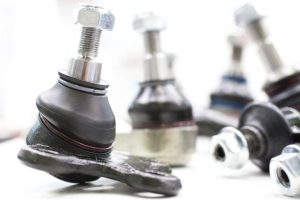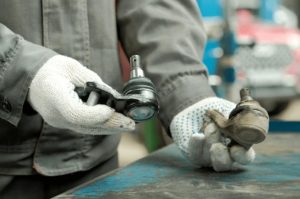Ball joints are vital components of a vehicle’s suspension and steering system, allowing the control arms and steering knuckle to move smoothly in multiple directions. Over time, these joints experience significant stress from road impacts, steering forces, and vehicle weight. When ball joints begin to wear, the symptoms may start subtly — but ignoring them can lead to dangerous failures, including loss of control. Recognizing early warning signs can save money on repairs and protect driver safety.
Why Ball Joint Wear Is Dangerous

Ball joints maintain wheel alignment, steering precision, and suspension stability. As they wear out, they develop excessive play, which can cause the wheel to tilt, vibrate, or even collapse. Severe ball joint failure may cause the wheel to fold under the vehicle, making the car impossible to steer.
This is why spotting early symptoms is critical.
Top Symptoms of Worn Ball Joints
Below are the most common warning signs that indicate ball joint wear. Some symptoms appear only under certain conditions, making regular inspections essential.
1. Clunking or Knocking Noises
One of the earliest and most noticeable signs is a clunking sound when driving over bumps, potholes, or uneven surfaces. This noise occurs because the worn ball joint allows the suspension components to move excessively.
Key characteristics:
-
Noise from the front suspension
-
Louder over bumps
-
Often accompanied by looseness in steering
2. Excessive Steering Play
A worn ball joint can create play or looseness in the steering wheel. Drivers may notice:
-
Steering feels vague
-
Difficulties maintaining a straight line
-
Increased steering wheel movement without wheel response
This happens because the ball joint can no longer hold the steering knuckle firmly in place.
3. Uneven or Accelerated Tire Wear
Ball joint wear affects wheel alignment, especially camber angle, causing the tire to contact the road unevenly.
Common wear patterns caused by bad ball joints:
-
Inner or outer edge wear
-
Feathering (smooth one way, rough the other)
-
Rapid wear on one front tire
4. Vibration in the Front Suspension
As the ball joint becomes loose, the wheel can wobble while driving, creating noticeable vibration that increases with speed.
Common symptoms:
-
Steering wheel shaking
-
Vibration through the floor
-
Worsening at highway speeds
If vibration is present along with noise, ball joint wear is highly likely.
5. Vehicle Pulling to One Side
As alignment shifts, the vehicle may begin drifting or pulling to one direction.
Causes include:
-
Camber misalignment
-
Steering knuckle instability
-
Uneven suspension geometry
While pulling may also result from tire or brake issues, worn ball joints are a common contributor.
6. Visible Ball Joint Play During Inspection
During a physical check, mechanics often test ball joints by lifting the vehicle and moving the wheel manually.
Signs of worn ball joints:
-
Wheel movement up/down or side/side
-
Clunking during manual movement
-
Torn or leaking rubber boots
-
Rust or dry appearance around the joint
If the boot is damaged, dirt enters and accelerates wear.
Ball Joint Symptoms Comparison Table
| Symptom | Likely Cause | Severity |
|---|---|---|
| Clunking over bumps | Excessive joint play | High |
| Steering looseness | Worn internal bearing | Medium |
| Uneven tire wear | Alignment shift | Medium to high |
| Vibration at speed | Loose ball stud | High |
| Pulling to one side | Camber imbalance | Medium |
| Wheel wobble when lifted | Joint near failure | Critical |
How to Spot Ball Joint Wear Early
Catching ball joint problems early can prevent suspension damage, reduce tire wear, and avoid dangerous failures. Here’s how to detect issues before they escalate.
Routine Visual Inspection
Look for:
-
Torn or leaking boots
-
Rust or corrosion
-
Grease leaking out
-
Contaminants stuck to the boot
A damaged boot means the ball joint will wear out quickly.
Listen for Noises During Driving
Pay attention to:
-
Clunks over bumps
-
Squeaks during turning
-
Metallic tapping during acceleration or braking
Tracking when noises occur helps identify whether the ball joint or another component is at fault.
Perform a Manual Wheel Play Test
With the car lifted:
-
Grip the wheel at 12 and 6 o’clock
-
Push and pull to check for vertical play
-
Then grip at 3 and 9 o’clock
-
Check for horizontal movement
Any noticeable movement often indicates ball joint wear or a loose control arm bushing.
Monitor Tire Wear Patterns
Check tires regularly for:
-
Uneven shoulder wear
-
Rapid edge wear
-
Strange patterns or feathering
This is one of the earliest indirect signs of ball joint problems.
Where to Buy Replacement Ball Joints

If any of the symptoms appear, replacing the ball joint promptly is essential for safety. You can Buy Ball Joints online from reliable manufacturers here:
Buy Ball Joints online
The selection includes both upper and lower ball joints for a wide range of vehicle models.
Conclusion
Worn ball joints are not just a minor inconvenience — they directly impact steering, stability, and safety. Early symptoms such as clunking noises, steering looseness, uneven tire wear, and front-end vibrations should never be ignored. Since ball joints deteriorate gradually, recognizing early signs allows you to schedule repairs before the situation becomes dangerous. Regular inspections, awareness of symptoms, and timely replacement ensure smoother handling, longer tire life, and safer driving.